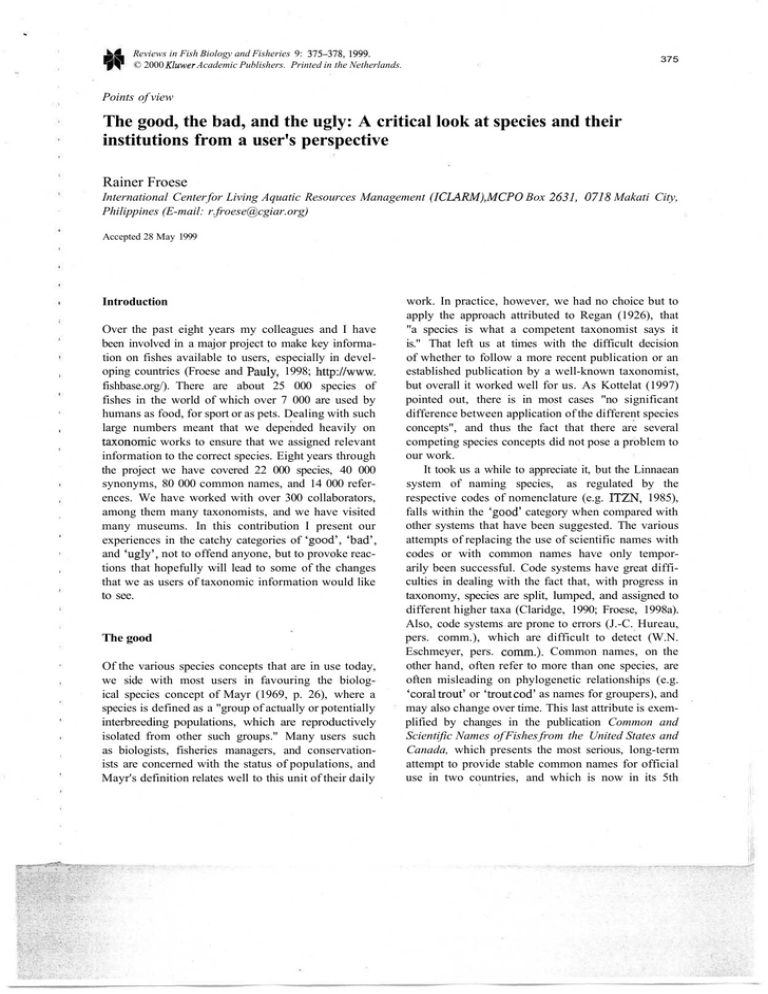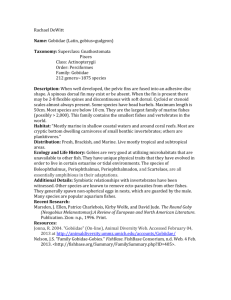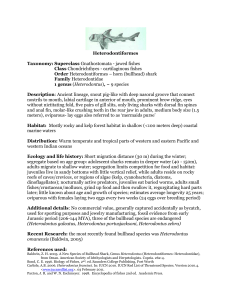The good, the bad, and the ugly: A critical look... institutions from a user's perspective
advertisement

Reviews in Fish Biology and Fisheries 9: 375-378,1999. © 2000 Kluwer Academic Publishers. Printed in the Netherlands. 375 Points of view The good, the bad, and the ugly: A critical look at species and their institutions from a user's perspective Rainer Froese International Center for Living Aquatic Resources Management (ICLARM), MCPO Box 2631, 0718 Makati City, Philippines (E-mail: r.froese@cgiar.org) Accepted 28 May 1999 Introduction Over the past eight years my colleagues and I have been involved in a major project to make key information on fishes available to users, especially in developing countries (Froese and Pauly, 1998; http://www. fishbase.org/). There are about 25 000 species of fishes in the world of which over 7 000 are used by humans as food, for sport or as pets. Dealing with such large numbers meant that we depended heavily on taxonomic works to ensure that we assigned relevant information to the correct species. Eight years through the project we have covered 22 000 species, 40 000 synonyms, 80 000 common names, and 14 000 references. We have worked with over 300 collaborators, among them many taxonomists, and we have visited many museums. In this contribution I present our experiences in the catchy categories of 'good', 'bad', and 'ugly', not to offend anyone, but to provoke reactions that hopefully will lead to some of the changes that we as users of taxonomic information would like to see. The good Of the various species concepts that are in use today, we side with most users in favouring the biological species concept of Mayr (1969, p. 26), where a species is defined as a "group of actually or potentially interbreeding populations, which are reproductively isolated from other such groups." Many users such as biologists, fisheries managers, and conservationists are concerned with the status of populations, and Mayr's definition relates well to this unit of their daily " ''•- : ' • • work. In practice, however, we had no choice but to apply the approach attributed to Regan (1926), that "a species is what a competent taxonomist says it is." That left us at times with the difficult decision of whether to follow a more recent publication or an established publication by a well-known taxonomist, but overall it worked well for us. As Kottelat (1997) pointed out, there is in most cases "no significant difference between application of the different species concepts", and thus the fact that there are several competing species concepts did not pose a problem to our work. It took us a while to appreciate it, but the Linnaean system of naming species, as regulated by the respective codes of nomenclature (e.g. ITZN, 1985), falls within the 'good' category when compared with other systems that have been suggested. The various attempts of replacing the use of scientific names with codes or with common names have only temporarily been successful. Code systems have great difficulties in dealing with the fact that, with progress in taxonomy, species are split, lumped, and assigned to different higher taxa (Claridge, 1990; Froese, 1998a). Also, code systems are prone to errors (J.-C. Hureau, pers. comm.), which are difficult to detect (W.N. Eschmeyer, pers. comm.). Common names, on the other hand, often refer to more than one species, are often misleading on phylogenetic relationships (e.g. 'coral trout' or 'trout cod' as names for groupers), and may also change over time. This last attribute is exemplified by changes in the publication Common and Scientific Names of Fishes from the United States and Canada, which presents the most serious, long-term attempt to provide stable common names for official use in two countries, and which is now in its 5th 376 edition (Robins et al., 1991). We share the widespread consensus that where codes and common names have a role this is only in addition to, not as a substitute for, scientific names. Some types of publications proved to be extremely helpful to our work and thus deserve mention in the 'good' category. These include global works such as Nelson's (1994) Fishes of the World, Eschmeyer's (1990) Catalog of the Genera of Recent Fishes and (1998) Catalog of Fishes, as well as large-scale, wellstructured family revisions such as those published by the Species Identification and Data Programme of the Food and Agriculture Organisation of the United Nations (FAO), and major faunal works such as Smith and Heemstra's (1986) Smith's Sea Fishes and Randall et al. (1990) Fishes of the Great Barrier Reef and Coral Sea. Also, various multiauthored checklists for large areas, such as CLOFFA (Daget et al., 1984) for the freshwater fishes of Africa, were extremely useful. Kottelat's (1997) European Freshwater Fishes enabled us to identify and clarify the nearly 2 000 scientific names that have been applied to some 350 European freshwater fishes. Similar works are urgently needed for the freshwater fishes of South America and of Asia. Most certainly the 'good' category encompasses the many taxonomists we have met over the years, and who, nearly without exception, were competent, patient and helpful. The bad In our view, the 'bad' category includes the concept of the subspecies. Some authors (e.g. Mayr, 1969) see the use of subspecies as a simplification of taxonomy. Our experience is exactly the opposite. The beautiful and simple concept of a species with a unique binominal name fixed to a type specimen that is kept in a museum for reference was spoiled when the various Taxonomic Codes (e.g. ITZN, 1985) provided for the use of valid names for units below the species level. This clearly is in conflict with the biological species concept (Mayr, 1969), where units below the species level are identified as populations. If a subspecies is the same as a population, why are some populations named as subspecies and others are not? This also leads to the confusing situation where a type specimen bears two different names, that of a species (e.g. Oreochromis niloticus) and that of the nominal subspecies (Oreochromis niloticus niloticus). There is widespread consensus that species, unlike higher taxa, are real natural entities (e.g. Kottelat, 1997). However, by introducing subspecies as another supposedly real entity below the species level, species and subspecies become somehow interchangeable units, with numerous negative consequences. For example, relational databases are well suited for handling large amounts of information in a structured and efficient way, and are the tool of choice for taxonomic and biological databases (Eschmeyer, 1990, 1998; Froese, 1998b). However, we could not find a satisfactory solution for dealing with subspecies in a relational database design. The hierarchy of class, order, family, genus, species, and populations has no place for occasional subspecies. In the design of FishBase (Froese and Pauly, 1998) we decided to treat subspecies as if they were species, but with a two-word entry in the field for the specific name (the species field). Eschmeyer, in the database that forms the basis of his Catalog of Fishes (1998), entered only the subspecific name in the species field and the generic and specific name together in the genus field. Others, e.g. Anon. (1997), have opted to create an additional field for the subspecific name, which, however, is usually empty. All of the above solutions are unsatisfactory and need various stopgaps to deal with the resulting inconsistencies. Fortunately, the subspecies concept is gradually falling out of favour with most current taxonomists who, in their revisionary work, either synonymize them or raise them to species rank. Another rating of 'bad' goes to the habit of some taxonomists of delivering a full description of a new species, with type specimens, measurements, meristics, drawing or photo, range, and some biology, but without naming the species other than 'sp. A' or 'sp. B'. Because a combination such as Raja sp. A (Last and Stevens, 1994) often is not unique, these names cannot be used in a relational database. A recent book on African fishes (Seehausen, 1996) even reverted to the use of multiword descriptive names, in a reversion to the naming practice of pre-Linnaean times. Whatever the reason for 'descriptions without names' may be, they thwart efforts to deliver useful information because there is no name to which the information can be attached. For a while we tried to uncover valid names in the subsequent literature, but this turned out to be very time consuming even if we had subsequent family revisions at hand (just try to find Epinephelus sp. A in a revision treating over 100 species in over 300 pages), and thus we decided to ignore such cases. 377 And that brings us to another important item in the 'bad' category. How is the user supposed to find out what scientific name and spelling is currently valid? Froese and Capuli (1998) pointed out the difficulties that nontaxonomists have in reading synonymies. More importantly, most users of scientific names are unlikely to find or obtain publications containing synonymies. Eschmeyer's (1998) Catalog of Fishes cites publications containing either new species descriptions or information referring to the status of scientific names. There are 8 976 relevant works published between 1950 and 1998 in 1 272 different journals, books, and other outlets, and, presumably, in as many different formats. The Zoological Record indexes taxonomic publications in zoology and thus will contain most of the 8 976 publications (Edwards, 1990). However, when searched for a scientific name, it will find many but not all of the relevant references, because it does not index all species treated in a reference. Clearly, the taxonomic community has failed to provide a pragmatic, authoritative, regularly updated, widely available, and user-friendly system where the many users of scientific names can quickly verify status and spelling. Eschmeyer's (1998) Catalog of Fishes is an excellent first step in that direction. The ugly This category, which no one will like very much, is reserved for what appear to be unwise decisions by the management of large taxonomic institutions, such as university departments and museums. Taxonomic institutions are publicly funded and given the mandate to provide information on the organisms of our world. Many such institutions suffered severe cutbacks in funding during the 1980s and 1990s (Claridge, 1990), possibly as a consequence of their public image as being old-fashioned and of little relevance. Instead of responding to this challenge by an internal reevaluation of their work, and by an effort to reinvent themselves and to redefine their place in science and society at the beginning of the 21st century, many administrations bowed to the pressure, terminated taxonomists, neglected and downsized collections, discouraged taxonomic work, started research in other areas such as ecology and aquaculture, and used their exhibits to promote popular but unrelated topics. Consequently, the big institutions found themselves left behind when, to their surprise, at the UNCED in Rio de Janeiro in 1993, the governments of the world got together to take action against the global loss of biodiversity. What caused such widespread and massive management failure? Why were administrations out of touch with science, society and their institutional mandate? Why did they choose to ignore or frustrate the many initiatives of their researchers who repeatedly pointed out the need to discover and describe the many remaining species, to join forces with the conservation community to stem the loss of species, to establish collaborative links with the countries that had supplied most of the specimens in their collections, and to embrace the new tools of the information age (databases, Internet), which so perfectly fit the task of making authoritative information on many species widely available? Discussing the difficulties associated with the management of large research institutions is beyond the scope of this article (see e.g. Jeffers, 1993; Amabile, 1998). However, in our private conversations with the staff of large scientific institutions, a pattern emerged that pointed to a common structural problem associated with hierarchical, top-down management. There seems to be a widening gap between increased executive power and relevant knowledge, amplified by a breakdown of professional communication between management and staff. In taxonomy, as in many other research endeavours, it is at the level of the researchers that one finds those who appear most dedicated to the mandate of their institution, who understand and advance the science, who write proposals, communicate with donors, run projects, are in contact with users, and who have visions most relevant to the future of the science and the institution. Despite their vital role and associated knowledge, researchers are often excluded completely from the decision-making process of such institutions. Their opinion is rarely asked for, and unsolicited advice is usually ignored or explicitly rejected. I do not have a suggestion for the perfect management system for research, but it seems. that systems derived from the business and military sector are not appropriate. Common sense suggests that any management structure that bypasses key actors is bound to fail. Acknowledgements I thank Roger Pullin and Daniel Pauly for helpful comments. The FishBase project is conducted under the joint Fisheries Research Initiative of African, Caribbean and Pacific (ACP) countries with the 378 European Union and is sponsored in the framework of the capacity-building project 'Strengthening of fisheries and biodiversity management in ACP countries' (7.ACP.RPR.545). References Amabile, T.A. (1998) How to kill creativity. Havard Business Review (September-October), 77-87. Anon. (1997) World Database on Legumes, Report on Tribe Vicieae. International Legume Database & Information Service, Southampton. 190 pp. Claridge, M.F. (1990) Biological diversity and systematic biology: The need for stable nomenclature. Biologist 38, 103-104. Daget, J., Gosse, J.-P. and Thys van den Audemarde, D.F.E., eds. (1984) Check-List of the Freshwater Fishes of Africa (CLOFFA), Vol. 1. Office de la Recherche Scientifique et Technique OutreMer, Paris and Musee Royal de 1'Afrique Centrale, Tervuren, Belgium. 410pp. Edwards, M. (1990) The Zoological Record - past and present. Biologist 37, 60-61. Eschmeyer, W.N. (1990) Catalog of the Genera of Recent Fishes. California Academy of Sciences, San Francisco. 697 pp. Eschmeyer, W.N., ed. (1998) Catalog of Fishes. Special Publication. California Academy of Sciences, San Francisco, 3 Vols. 2905 pp. Froese, R. and Pauly, D., eds. (1998) FishBase 98: Concepts, Design and Data Sources. ICLARM, Manila. 293 pp. Froese, R. (1998a) We don't believe in codes. In: Froese, R. and Pauly, D. eds. FishBase 98, Concepts, Design and Data Sources. ICLARM, Manila, p. 71. Froese, R. (1998b) The making of FishBase. In: Froese, R. and Pauly, D. eds. FishBase 98, Concepts, Design and Data Sources. ICLARM, Manila, pp. 8-22. Froese, R. and Capuli, E. (1998) The SYNONYMS table. In: Froese, R. and Pauly, D. eds. FishBase 98, Concepts, Design and Data Sources. ICLARM, Manila, pp. 84-87. ITZN (1985) International Code of Zoological Nomenclature. The International Trust for Zoological Nomenclature, London. Jeffers, J.N.R. (1993) Managing creativity. Biologist 40, 87-88. Kottelat, M. (1997) European freshwater fishes. Biologia 52(Suppl. 5), 1-271. Last, PR. and Stevens, J.D. (1994) Sharks and Rays of Australia. CSIRO, Australia. 513 pp. + 84 plates. Mayr, E. (1969) Principles of Systematic Zoology. McGraw-Hill, New York. 428 pp. Nelson, J.S. (1994) Fishes of the World, 3rd edn. John Wiley & Sons, Inc., New York. 600 pp. Randall, I.E., Allen, G.R. and Steene, R.C. (1990) Fishes of the Great Barrier Reef and Coral Sea. University of Hawaii Press, Honolulu. 506 pp. Regan, C.T. (1926) Organic evolutions. Rep. 93rdMeet. Brit. Assoc. Adv. Sci., 1925, pp. 75-86. Robins, C.R., Bailey, R.M., Bond, C.E., Brooker, J.R., Lachner, E.A., Lea, R.N. and Scott, W.B. (1991) Common and Scientific Names of Fishes from the United States and Canada, 5th edn., Vol. 20. Am. Fish. Soc. Spec. Pub. 183 pp. Seehausen, O. (1996) Lake Victoria Rock Cichlids. Aquaport Verlag, Aschaffenburg. 304 pp. Smith, M.M. and Heemstra, PC., eds. (1986) Smiths' Sea Fishes. Springer-Verlag, Berlin. 1047 pp.





